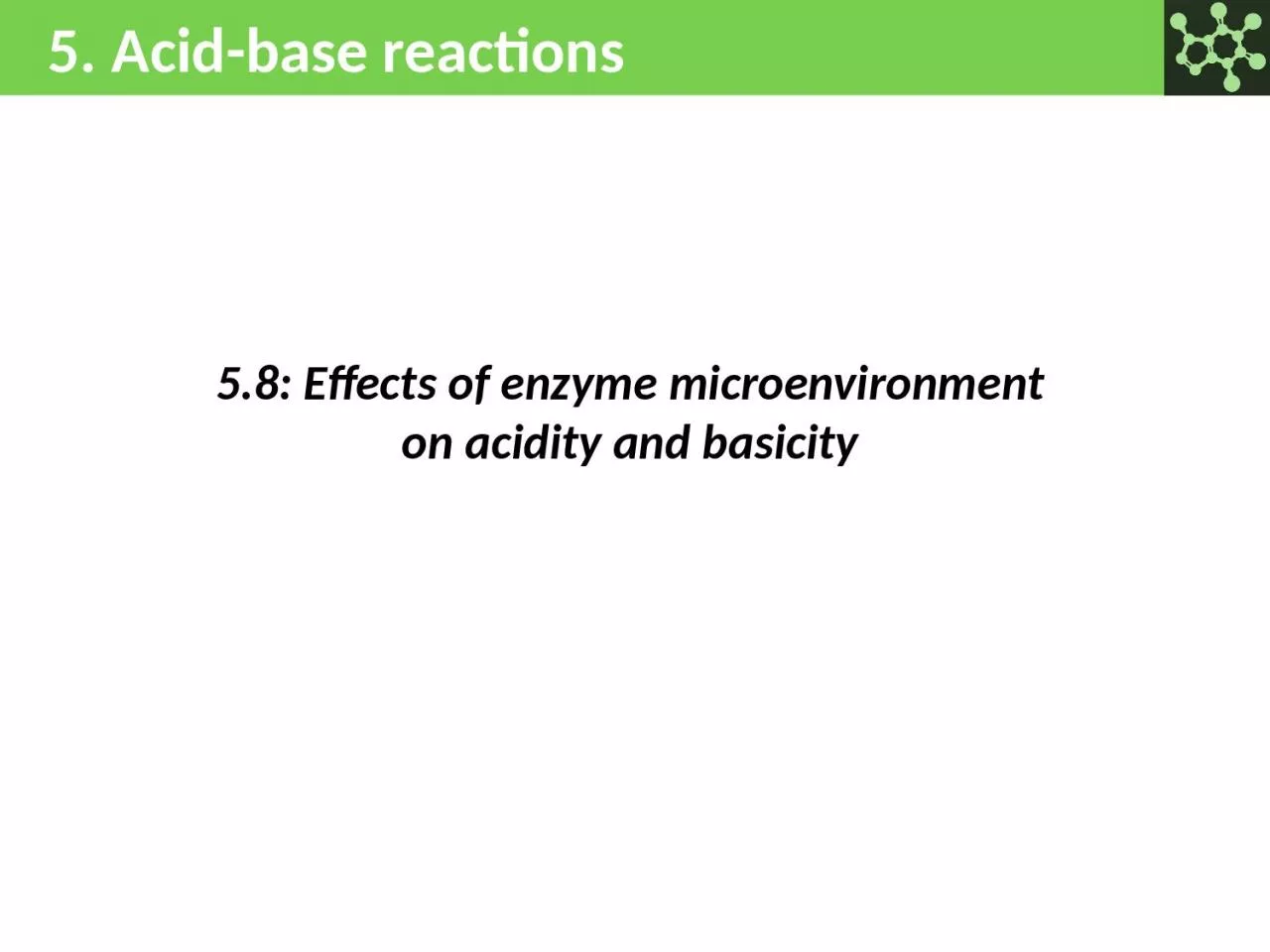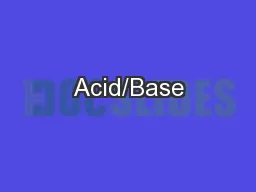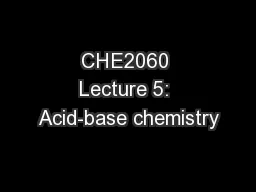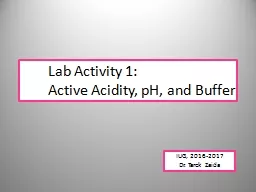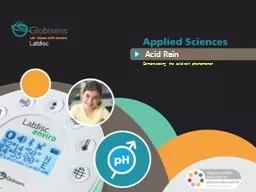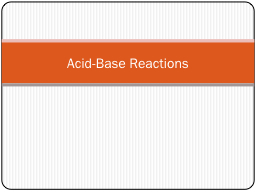PPT-5. Acid-base reactions 5.8: Effects of enzyme microenvironment on acidity and basicity
Author : piper | Published Date : 2024-02-09
Hydrophobic active site Most biochemical reactions occur in enzyme active sites not in bulk solution The active site microenvironment is often very different from
Presentation Embed Code
Download Presentation
Download Presentation The PPT/PDF document "5. Acid-base reactions 5.8: Effects of e..." is the property of its rightful owner. Permission is granted to download and print the materials on this website for personal, non-commercial use only, and to display it on your personal computer provided you do not modify the materials and that you retain all copyright notices contained in the materials. By downloading content from our website, you accept the terms of this agreement.
5. Acid-base reactions 5.8: Effects of enzyme microenvironment on acidity and basicity: Transcript
Hydrophobic active site Most biochemical reactions occur in enzyme active sites not in bulk solution The active site microenvironment is often very different from water Σ 1478 kJ mol. Chris Evans, Jane Hall, Ed Rowe. Why revisit peat? . Country. Peat area (km. 2. ). Russia (European). 213,000 . Finland. 85,000 . Sweden. 66,000 . Titration. Acid–Base Titration. The concentration of a weak acid or a weak base in water is difficult – if not impossible – to measure directly.. But we can calculate the concentration from the results of titration.. Ali Al-Mawlawi. What Is Stomach Acidity?. Stomach acidity is when you’re stomach produces to much acid (gastric). Acid has benefits but sometimes it crosses the line. . What It Does (damage)?. Stomach acidity causes you to have pain in the stomach and sometimes it causes diarrhea. . Lecturer Dr. . Kamal. E. M. . Elkahlout. Assistant Prof. of . Biotechnology. 1. CHAPTER 4. Recent Advances. 2. Enzymatic reactions in biphasic liquid systems. E. nzyme catalyzed . reactions could be performed in solvents other than . AKA Things you can taste or feel. Organoleptic Compounds of Wine. GOALS. To detect, or learn to detect, small differences in various compounds that are commonly found in wine. I will give a little scientific background on these various substances. Daley & . Daley. Chapter 5. :. Acid-base theory. 5.1 Acids & bases: overview & basics. 5.2 Acid & base strength. 5.3 Equilibrium acid-base reactions. 5.4 The leveling effect of solvents. IUG, 2016-2017. Dr. . Tarek. . Zaida. 1. Active Acidity. Refers to H. . present in a solution due to dissociation of acid.. Q:. . How can active acidity be expressed?. An: by pH of a solution.. 2. Pharmaceutical Medicinal Chemistry-I. Dr. Bilal Al-Jaidi. Assistant Professor in Medicinal Chemistry and Drug Design. Faculty of Pharmacy, Philadelphia University-Jordan. Email: bjaidi@philadelphia.edu.jo. 5.18.12. Go over pg. 74-75 and concept review . Lecture: Indicators and pH . (A) pg. 76-77. Universal Indicator. Bases. Acids. Phenolpthalein. Indicator. Identifies if a base is present: turns. . pink. Prof. Dr. Ir. Sri Kumalaningsih, M.App.Sc. SEQUENCE In Milk Fermentation. Raw milk is not free of micro-organisms. The animal may contribute organisms during the formation of milk in the mammary gland, but the greatest source of microoganisms in milk is external fermentation.. Acid. Rain. Demonstrating the acid rain phenomenon. Objective. The purpose of this activity is to investigate the effect of acid rain forerunner on water acidity, create a hypothesis and proceed to test it using the . Strong Acids. HCl. HBr. HI. HNO. 3. HClO. 4. H. 2. SO. 4. Acid: a species that supplies H. +. ions to water. Strong acid: an acid that completely ionizes in water forming an H. +. ion and an anion. Topics:. 3A_Chemical Reactions and . Stoichiometry. 3B_Types of Chemical Reactions. 3C_Driving Forces, Energy Changes and Electrochemistry. Topic 3A_Chemical Reactions and . Stoichiometry. Chemical Equations. by Jacob B. Geri, James V. Oakley, Tamara Reyes-Robles, Tao Wang, Stefan J. . McCarver. , Cory H. White, Frances P. Rodriguez-Rivera, Dann L. Parker, Erik C. . Hett. , . Olugbeminiyi. O. . Fadeyi. *.
Download Document
Here is the link to download the presentation.
"5. Acid-base reactions 5.8: Effects of enzyme microenvironment on acidity and basicity"The content belongs to its owner. You may download and print it for personal use, without modification, and keep all copyright notices. By downloading, you agree to these terms.
Related Documents

